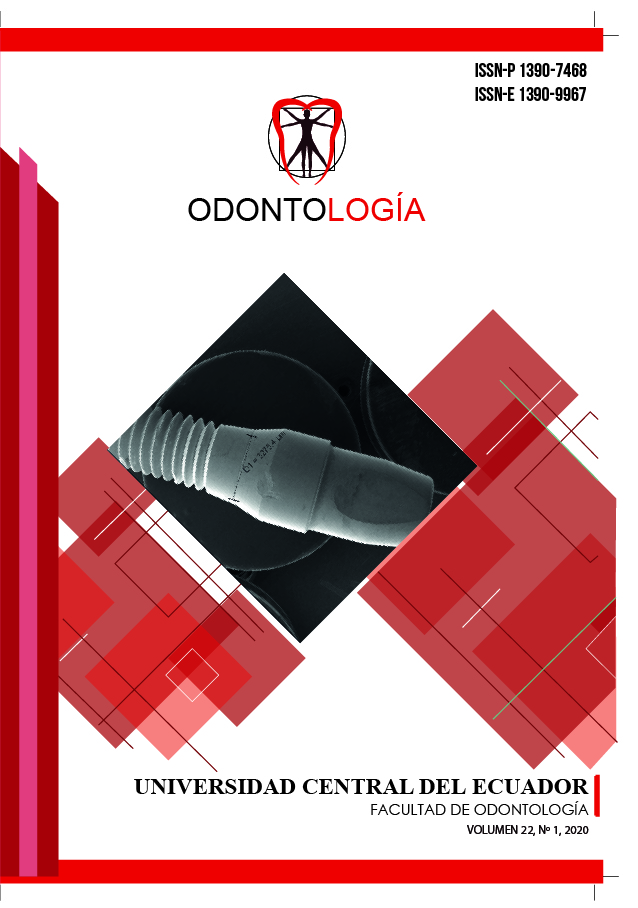Penetration in the pulp chamber of dental whitening with carbamide peroxide to different concentrations
DOI:
https://doi.org/10.29166/odontologia.vol22.n1.2020-5-20Keywords:
Calcium Hydroxide, Sealing cement, Tubular penetration, Confocal laser microscopyAbstract
The elimination of calcium hydroxide in the root canal is decisive for the success of endodontic treatment, the remnants can interact negatively with endodontic sealants increasing filtrations and decreasing the quality of the seal. Objective: To evaluate the effect of intra-duct medication with calcium hydroxide paste on the penetration of the sealing cement inside the dentinal tubules. Materials and methods: 20 distal roots of upper molars were instrumented using the Wave One Large 40 / .08 System. They were randomly divided into two groups: one sealed with a single cone technique and Ah plus cement with rhodamine-B and another sealed with the same technique and Ah plus cement with rhodamine B, previous placement for 15 days and removal by recapping the paste calcium hydroxide. Subsequently, the teeth were cut transversely and photomicrographs of the cervical, middle and apical third were performed using the laser scanning confocal microscopy technique. The maximum depth of penetration was determined through the Image J program. Results: The Ah plus sealing cement had lower penetration values when the calcium hydroxide paste was previously used as an intra-channel medication (p <0.01). The third of the duct with the highest penetration was the cervical third followed by the middle third and finally the apical (p <0.01). Conclusion: Remaining calcium hydroxide decreases the penetration of the sealing cement Ah plus in the dentinal tubules in all thirds of the root canal.
Downloads
References
Cedillo Orellana SI. Efectos del blanqueamiento dental sobre el tejido pulpar. 2016;1–46. Available from: http://dspace.ucuenca.edu.ec/handle/123456789/24808
Cedeño J. Creencias y mitos del blanqueamiento dental en los habitantes de la parroquia San Mateo periodo 2016-2017. 2017;9:1–50.
Batista G, Barcellos D, Torres C, Goto E, Pucci C, Borges A. The Influence of Chemical Activation on Tooth Bleaching Using 10% Carbamide Peroxide. Oper Dent [Internet]. 2011;36(2):162–8. Available from: http://www.jopdentonline.org/doi/10.2341/09-280-L
Demarco FF, Meireles SS, Sarmento HR, Dantas RVF, Botero T, Tarquinio SBC. Erosion and abrasion on dental structures undergoing at-home bleaching. Clin Cosmet Investig Dent. 2011;3:45–52.
de Oliveira Duque CC, Soares DG, Basso FG, Hebling J, de Souza Costa CA. Bleaching effectiveness, hydrogen peroxide diffusion, and cytotoxicity of a chemically activated bleaching gel. Clin Oral Investig. 2013;18(6):1631–7.
Goldberg M, Grootveld M, Lynch E. Undesirable and adverse effects of tooth-whitening products: A review. Clin Oral Investig. 2010;14(1):1–10.
Hyland BW, McDonald A, Lewis N, Tredwin C, Petrie A, Hall S, et al. A new three-component formulation for the efficient whitening of teeth (Carbamide Plus). Clin Oral Investig. 2014;19(6):1395–404.
Borges B, Borges J, de Melo C, Pinheiro I, Santos A dos, Braz R, et al. Efficacy of a Novel At-home Bleaching Technique With Carbamide Peroxides Modified by CPP-ACP and Its Effect on the Microhardness of Bleached Enamel. Oper Dent [Internet]. 2011;36(5):521–8. Available from: http://www.jopdentonline.org/doi/10.2341/11-013-L
Hirata R, Higashi C. Blanqueamiento dental: Concepto y sustancias blanqueadoras. Médica Pan. 2012. 385 p.
Costa CAS, Riehl H, Kina JF, Sacono NT, Hebling J. Human pulp responses to in-office tooth bleaching. J Esthet Restor Dent [Internet]. 2014;26(5):356. Available from: http://dx.doi.org/10.1016/j.tripleo.2009.12.002
Baxter R, Hastings N, Law A, Glass EJ. Blanqueamiento Dental. Anim Genet. 2008;39(5):561–3.
Solís Cessa E. Aclaramiento dental: revisión de la literatura y presentación de un caso clínico. Dental clearance: review of the literature and case report. Rev ADM [Internet]. 2018;75(1):9–25. Available from: www.medigraphic.com/adm
Kwon S, Pallavi F, Shi Y, Oyoyo U, Mohraz A, Li Y. Effect of Bleaching Gel Viscosity on Tooth Whitening Efficacy and Pulp Chamber Penetration: An In Vitro Study. Oper Dent [Internet]. 2018;43(3):326–34. Available from: http://www.jopdentonline.org/doi/10.2341/17-099-L
Reis A, Kossatz S, Martins G, Loguercio A. Efficacy of and Effect on Tooth Sensitivity of In-office Bleaching Gel Concentrations: A Randomized Clinical Trial. Oper Dent [Internet]. 2013;38(4):386–93. Available from: http://www.jopdentonline.org/doi/10.2341/12-140-C
Patri G, Agnihotri Y, Rao SR, Lakshmi N, Das S. An in Vitro Spectrophotometric Analysis of the Penetration of Bleaching Agent into the Pulp Chamber of Intact and Restored Teeth. 2013;7(12):3057–9.
Patri G, Acharya G, Agrawal P, Panda V. Spectrophotometric evaluation of the pulpal peroxide levels in intact and restored teeth - An invitro study. J Clin Diagnostic Res. 2016;10(8):ZC44–7.
Marson F, Goncalves R, Silva C, Cintra L, Pascotto R, Santos P, et al. Penetration of Hydrogen Peroxide and Degradation Rate of Different Bleaching Products. Oper Dent. 2015;72–9.
Bauminger BB. Micro method for manual analysis of true glucose in plasma without deproteinization. 1974;1015–7.
Hannig C, Za R, Henze E, Dreier S, Attin T. Peroxide release into saliva from five different home bleaching systems in vivo. 2005;18(1):15810475.
Gomes CR, Wiegand A, Sener B, Attin T. Influence of chemical activation of a 35% hydrogen peroxide bleaching gel on its penetration and efficacy - In vitro study. J Dent [Internet]. 2010;38(10):838–46. Available from: http://dx.doi.org/10.1016/j.jdent.2010.07.002
Soares DG, Gonçalves Basso F, Hebling J, De Souza Costa CA. Effect of hydrogen-peroxide-mediated oxidative stress on human dental pulp cells. J Dent. 2015;43(6):750–6.
Published
How to Cite
Issue
Section
License
Copyright (c) 2020 Erika Paola Herrera Jácome, David Sebastián Flores Cuvi, Dennys Paul Almachi Villalba, Pablo Rubén Garrido Villavicencio

This work is licensed under a Creative Commons Attribution-NonCommercial-NoDerivatives 4.0 International License.


